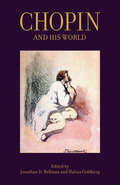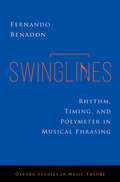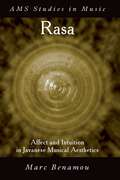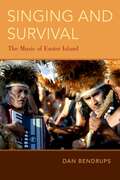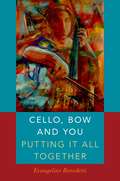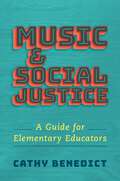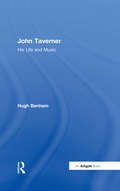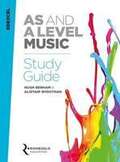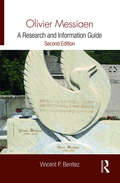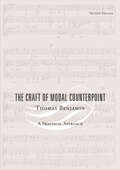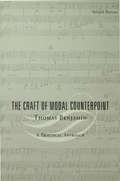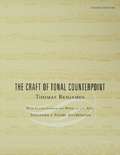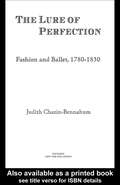- Table View
- List View
Chopin and His World (PDF)
by Jonathan D. Bellman Halina GoldbergA new look at the life, times, and music of Polish composer and piano virtuoso Fryderyk ChopinFryderyk Chopin (1810–49), although the most beloved of piano composers, remains a contradictory figure, an artist of virtually universal appeal who preferred the company of only a few sympathetic friends and listeners. Chopin and His World reexamines Chopin and his music in light of the cultural narratives formed during his lifetime. These include the romanticism of the ailing spirit, tragically singing its death-song as life ebbs; the Polish expatriate, helpless witness to the martyrdom of his beloved homeland, exiled among friendly but uncomprehending strangers; the sorcerer-bard of dream, memory, and Gothic terror; and the pianist's pianist, shunning the appreciative crowds yet composing and improvising idealized operas, scenes, dances, and narratives in the shadow of virtuoso-idol Franz Liszt. The international Chopin scholars gathered here demonstrate the ways in which Chopin responded to and was understood to exemplify these narratives, as an artist of his own time and one who transcended it. This collection also offers recently rediscovered artistic representations of his hands (with analysis), and—for the first time in English—an extended tribute to Chopin published in Poland upon his death and contemporary Polish writings contextualizing Chopin's compositional strategies. The contributors are Jonathan D. Bellman, Leon Botstein, Jean-Jacques Eigeldinger, Halina Goldberg, Jeffrey Kallberg, David Kasunic, Anatole Leikin, Eric McKee, James Parakilas, John Rink, and Sandra P. Rosenblum. Contemporary documents by Karol Kurpiński, Adam Mickiewicz, and Józef Sikorski are included.
Swinglines: Rhythm, Timing, and Polymeter in Musical Phrasing (OXFORD STUDIES IN MUSIC THEORY)
by Fernando BenadonThe way rhythm is taught in Western classrooms and music lessons is rooted in a centuries-old European approach that favors metric levels within a grand symmetrical grid. Swinglines encourages readers to experience rhythms, even gridded ones, as freewheeling affairs irrespective of the metric hierarchy. At its core, this book is a nuts-and-bolts study of durational comparisons in the context of creative expression. It shows that rhythms traditionally framed as "deviations" and "non-isochronous" have their own identities. They are coherent products of precise musical thought and action. Rather than situating them in the neither-here-nor-there, author Fernando Benadon takes a more inclusive view, one where isochrony and metric grids are shown as particular cases within the universe of musical time. Rhythms that do not readily comply with the metered regime are often regarded as anomalies and deformations. The music explored in this book demonstrates how readily this paradigm vanishes once the frame is flipped from what rhythm is not to what rhythm is. As conceptualized here, swing flattens the temporal field to consider how note values relate to one another by any magnitude, not just the simple ratios of traditional theory. Musical analyses illustrate the book's concepts with the aid of transcriptions and timing-data visualizations. Variation, tuplets, polymeter, displacement, phrase structure, rhythmic counterpoint, parallel tempos, cyclical patterns, and time signatures are shown to be particular expressions that draw their contours from the swing continuum. They showcase the rich diversity of rhythm and propose ways to reframe how we think about musical time.
Swinglines: Rhythm, Timing, and Polymeter in Musical Phrasing (OXFORD STUDIES IN MUSIC THEORY)
by Fernando BenadonThe way rhythm is taught in Western classrooms and music lessons is rooted in a centuries-old European approach that favors metric levels within a grand symmetrical grid. Swinglines encourages readers to experience rhythms, even gridded ones, as freewheeling affairs irrespective of the metric hierarchy. At its core, this book is a nuts-and-bolts study of durational comparisons in the context of creative expression. It shows that rhythms traditionally framed as "deviations" and "non-isochronous" have their own identities. They are coherent products of precise musical thought and action. Rather than situating them in the neither-here-nor-there, author Fernando Benadon takes a more inclusive view, one where isochrony and metric grids are shown as particular cases within the universe of musical time. Rhythms that do not readily comply with the metered regime are often regarded as anomalies and deformations. The music explored in this book demonstrates how readily this paradigm vanishes once the frame is flipped from what rhythm is not to what rhythm is. As conceptualized here, swing flattens the temporal field to consider how note values relate to one another by any magnitude, not just the simple ratios of traditional theory. Musical analyses illustrate the book's concepts with the aid of transcriptions and timing-data visualizations. Variation, tuplets, polymeter, displacement, phrase structure, rhythmic counterpoint, parallel tempos, cyclical patterns, and time signatures are shown to be particular expressions that draw their contours from the swing continuum. They showcase the rich diversity of rhythm and propose ways to reframe how we think about musical time.
RASA: Affect and Intuition in Javanese Musical Aesthetics (AMS Studies in Music)
by Marc BenamouThe complex notion of "rasa," as understood by Javanese musicians, refers to a combination of various qualities, including: taste, feeling, affect, mood, sense, inner meaning, a faculty of knowing intuitively, and deep understanding. This leaves us with a number of questions: how is rasa expressed musically? Who or what has rasa, and what sorts of musical, psychological, perceptual, and sociological distinctions enter into this determination? How is the vocabulary of rasa structured, and what does this tell us about traditional Javanese music and aesthetics? In this first book on the subject, Rasa provides an entry into Javanese music as it is conceived by the people who know the tradition best: the musicians themselves. In one of the most thorough explorations of local aesthetics to date, author Marc Benamou argues that musical meaning is above all connotative - hence, not only learned, but learnable. Following several years performing and researching Javanese music in the regional and national cultural center of Solo, Indonesia, Benamou untangles the many meanings of rasa as an aesthetic criterion in Javanese music, particularly in court and court-derived gamelan traditions. While acknowledging that certain universal psychological tendencies may inspire parallel interpretations of musical meaning, Rasa demonstrates just how culturally specific such accrued, shared meanings can be.
Rasa: Affect and Intuition in Javanese Musical Aesthetics (AMS Studies in Music)
by Marc BenamouThe complex notion of "rasa," as understood by Javanese musicians, refers to a combination of various qualities, including: taste, feeling, affect, mood, sense, inner meaning, a faculty of knowing intuitively, and deep understanding. This leaves us with a number of questions: how is rasa expressed musically? Who or what has rasa, and what sorts of musical, psychological, perceptual, and sociological distinctions enter into this determination? How is the vocabulary of rasa structured, and what does this tell us about traditional Javanese music and aesthetics? In this first book on the subject, Rasa provides an entry into Javanese music as it is conceived by the people who know the tradition best: the musicians themselves. In one of the most thorough explorations of local aesthetics to date, author Marc Benamou argues that musical meaning is above all connotative - hence, not only learned, but learnable. Following several years performing and researching Javanese music in the regional and national cultural center of Solo, Indonesia, Benamou untangles the many meanings of rasa as an aesthetic criterion in Javanese music, particularly in court and court-derived gamelan traditions. While acknowledging that certain universal psychological tendencies may inspire parallel interpretations of musical meaning, Rasa demonstrates just how culturally specific such accrued, shared meanings can be.
Singing and Survival: The Music of Easter Island
by Dan BendrupsAn exemplary investigation into music and sustainability, Singing and Survival tells the story of how music helped the Rapanui people of Easter Island to preserve their unique cultural heritage. Easter Island (or Rapanui), known for the iconic headstones (moai) that dot the island landscape, has a remarkable and enduring presence in global popular culture where it has been portrayed as a place of mystery and fascination, and as a case study in societal collapse. These portrayals often overlook the remarkable survival of the Rapanui people who rebounded from a critically diminished population of just 110 people in the late nineteenth century to what is now a vibrant community where indigenous language and cultural practices have been preserved for future generations. This cultural revival has drawn on a diversity of historical and contemporary influences: indigenous heritage, colonial and missionary influences from South America, and cultural imports from other Polynesian islands, as well as from tourism and global popular culture. The impact of these influences can be perceived in the island's contemporary music culture. This book provides a comprehensive overview of Easter Island music, with individual chapters devoted to the various streams of cultural influence from which the Rapanui people have drawn to rebuild and reinforce their music, their performances, their language and their presence in the world. In doing so, it provides a counterpoint to deficit discourses of collapse, destruction and disappearance to which the Rapanui people have historically been subjected.
SINGING & SURVIVAL C: The Music of Easter Island
by Dan BendrupsAn exemplary investigation into music and sustainability, Singing and Survival tells the story of how music helped the Rapanui people of Easter Island to preserve their unique cultural heritage. Easter Island (or Rapanui), known for the iconic headstones (moai) that dot the island landscape, has a remarkable and enduring presence in global popular culture where it has been portrayed as a place of mystery and fascination, and as a case study in societal collapse. These portrayals often overlook the remarkable survival of the Rapanui people who rebounded from a critically diminished population of just 110 people in the late nineteenth century to what is now a vibrant community where indigenous language and cultural practices have been preserved for future generations. This cultural revival has drawn on a diversity of historical and contemporary influences: indigenous heritage, colonial and missionary influences from South America, and cultural imports from other Polynesian islands, as well as from tourism and global popular culture. The impact of these influences can be perceived in the island's contemporary music culture. This book provides a comprehensive overview of Easter Island music, with individual chapters devoted to the various streams of cultural influence from which the Rapanui people have drawn to rebuild and reinforce their music, their performances, their language and their presence in the world. In doing so, it provides a counterpoint to deficit discourses of collapse, destruction and disappearance to which the Rapanui people have historically been subjected.
Cello, Bow and You: Putting it All Together
by Evangeline BenedettiWritten for the cellist looking for an approach that demystifies cello playing, Cello, Bow and You is an innovative text in the field of string pedagogy written by a 40+ year veteran of the New York Philharmonic Orchestra and certified teacher of the Alexander Technique. Author Evangeline Benedetti has a unique voice and approach, and invites cellists of all levels to explore, make discoveries and organically internalize technique. Benedetti's approach compliments the work that students do with their teachers by encouraging them to be more aware of themselves and responsive to internal and external guidance. Cello, Bow and You allows students and professionals access to Benedetti's vast performance and teaching experience. She has pioneered an approach to playing that is a synthesis of the cellist's musical thought, the knowledge of the dynamic properties of the instrument and bow, and the ability to move effectively according to the mechanics of the human body. The synergy of these elements leads to physically healthy playing and frees players to be musically expressive. Written in engaging, informal prose, the book is a must-read for cellists and cello teachers - beginning, intermediate, or professional.
CELLO, BOW & YOU C
by Evangeline BenedettiWritten for the cellist looking for an approach that demystifies cello playing, Cello, Bow and You is an innovative text in the field of string pedagogy written by a 40+ year veteran of the New York Philharmonic Orchestra and certified teacher of the Alexander Technique. Author Evangeline Benedetti has a unique voice and approach, and invites cellists of all levels to explore, make discoveries and organically internalize technique. Benedetti's approach compliments the work that students do with their teachers by encouraging them to be more aware of themselves and responsive to internal and external guidance. Cello, Bow and You allows students and professionals access to Benedetti's vast performance and teaching experience. She has pioneered an approach to playing that is a synthesis of the cellist's musical thought, the knowledge of the dynamic properties of the instrument and bow, and the ability to move effectively according to the mechanics of the human body. The synergy of these elements leads to physically healthy playing and frees players to be musically expressive. Written in engaging, informal prose, the book is a must-read for cellists and cello teachers - beginning, intermediate, or professional.
Music and Social Justice: A Guide for Elementary Educators
by Cathy BenedictIn this book author Cathy Benedict challenges and reframes traditional ways of addressing many of the topics we have come to think of as social justice. Offering practical suggestions for helping both teachers and students think philosophically (and thus critically) about the world around them, each chapter engages with important themes through music making and learning as it presents scenarios, examples of dialogue with students, unit ideas and lesson plans geared toward elementary students (ages 6-14). Taken-for-granted subjects often considered beyond the understanding of elementary students such as friendship, racism, poverty, religion, and class are addressed and interrogated in such a way that honours the voice and critical thinking of the elementary student. Suggestions are given that help both teachers and students to pause, reflect and redirect dialogue with questions that uncover bias, misinformation and misunderstandings that too often stand in the way of coming to know and embracing difference. Guiding questions, which anchor many curricular mandates, are used throughout in order to scaffold critical and reflective thinking beginning in the earliest grades of elementary music education. Where does social justice reside? Whose voice is being heard and whose is being silenced? How do we come to think of and construct poverty? How is it that musics become used the way they are used? What happens to songs initially intended for socially driven purposes when their significance is undermined? These questions and more are explored encouraging music teachers to embrace a path toward socially just engagements at the elementary and middle school levels.
MUSIC & SOCIAL JUSTICE C: A Guide for Elementary Educators
by Cathy BenedictIn this book author Cathy Benedict challenges and reframes traditional ways of addressing many of the topics we have come to think of as social justice. Offering practical suggestions for helping both teachers and students think philosophically (and thus critically) about the world around them, each chapter engages with important themes through music making and learning as it presents scenarios, examples of dialogue with students, unit ideas and lesson plans geared toward elementary students (ages 6-14). Taken-for-granted subjects often considered beyond the understanding of elementary students such as friendship, racism, poverty, religion, and class are addressed and interrogated in such a way that honours the voice and critical thinking of the elementary student. Suggestions are given that help both teachers and students to pause, reflect and redirect dialogue with questions that uncover bias, misinformation and misunderstandings that too often stand in the way of coming to know and embracing difference. Guiding questions, which anchor many curricular mandates, are used throughout in order to scaffold critical and reflective thinking beginning in the earliest grades of elementary music education. Where does social justice reside? Whose voice is being heard and whose is being silenced? How do we come to think of and construct poverty? How is it that musics become used the way they are used? What happens to songs initially intended for socially driven purposes when their significance is undermined? These questions and more are explored encouraging music teachers to embrace a path toward socially just engagements at the elementary and middle school levels.
John Taverner: His Life and Music
by Hugh BenhamJohn Taverner was the leading composer of church music under Henry VIII. His contributions to the mass and votive antiphon are varied, distinguished and sometimes innovative; he has left more important settings for the office than any of his predecessors, and even a little secular music survives. Hugh Benham, editor of Taverner‘s complete works for Early English Church Music, now provides the first full-length study of the composer for over twenty years. He places the music in context, with the help of biographical information, discussion of Taverner‘s place in society, and explanation of how each piece was used in the pre-Reformation church services. He investigates the musical language of Taverner‘s predecessors as background for a fresh examination and appraisal of the music in the course of which he traces similarities with the work of younger composers. Issues confronting the performer are considered, and the music is also approached from the listener‘s point of view, initially through close analytical inspection of the celebrated votive antiphon Gaude plurimum.
John Taverner: His Life and Music
by Hugh BenhamJohn Taverner was the leading composer of church music under Henry VIII. His contributions to the mass and votive antiphon are varied, distinguished and sometimes innovative; he has left more important settings for the office than any of his predecessors, and even a little secular music survives. Hugh Benham, editor of Taverner‘s complete works for Early English Church Music, now provides the first full-length study of the composer for over twenty years. He places the music in context, with the help of biographical information, discussion of Taverner‘s place in society, and explanation of how each piece was used in the pre-Reformation church services. He investigates the musical language of Taverner‘s predecessors as background for a fresh examination and appraisal of the music in the course of which he traces similarities with the work of younger composers. Issues confronting the performer are considered, and the music is also approached from the listener‘s point of view, initially through close analytical inspection of the celebrated votive antiphon Gaude plurimum.
Edexcel AS And A Level Music (PDF)
by Hugh Benham Alistair WightmanWritten by an experienced teacher and examiner, these tests will help to prepare you for the Listening and Appraising exam for your AS or A Level course. It covers the pieces you will study for AS (June 2018) and A Level (June 2018 and June 2019). This book contains: Practice questions for Areas of Study 1 and 2, for both Section A and Section B (Prescribed works) A scores insert Answers to all the questions Downloadable audio for all the tests
Edexcel AS and A Level Music Study Guide
by Hugh Benham Alistair WightmanA definitive study guide for the AS and A Level syllabuses. This comprehensive guide: • supports all components of the AS and A Level courses: Performing, Composing and Appraising • covers every set work in detail • provides guidance on the full list of composition briefs • includes tests and practice essay questions
Edexcel AS and A Level Music Study Guide (PDF)
by Hugh Benham Alistair WightmanA definitive study guide for the AS and A Level syllabuses. This comprehensive guide: • supports all components of the AS and A Level courses: Performing, Composing and Appraising • covers every set work in detail • provides guidance on the full list of composition briefs • includes tests and practice essay questions
Olivier Messiaen: A Research and Information Guide (Routledge Music Bibliographies)
by Vincent BenitezOlivier Messiaen: A Research and Information Guide, Second Edition presents researchers with the most significant and helpful resources on Olivier Messiaen, one of the twentieth century's greatest composers. With multiple indices, this annotated bibliography will serve as an excellent tool for librarians, researchers, and scholars sorting through the massive amount of material in the field. The second edition has been fully revised and updated.
Olivier Messiaen: A Research and Information Guide (Routledge Music Bibliographies)
by Vincent BenitezOlivier Messiaen: A Research and Information Guide, Second Edition presents researchers with the most significant and helpful resources on Olivier Messiaen, one of the twentieth century's greatest composers. With multiple indices, this annotated bibliography will serve as an excellent tool for librarians, researchers, and scholars sorting through the massive amount of material in the field. The second edition has been fully revised and updated.
The Craft of Modal Counterpoint: A Practical Approach
by Thomas Benjamin"The Craft of Modal Counterpoint" is the companion book to Benjamin's "The Craft of Tonal Counterpoint," recently republished in a second edition by Routledge. Modal counterpoint is the style of composition that was employed until the "tonal" revolution pioneered by Bach; it is the basis for most Early Music. Benjamin, a composer and pedagogue, offers a complete analysis of this important musical style. He begins by covering general aspects of the style, then covers in detail two, three, and four-part counterpoint. The Motet, an important form of vocal composition in this period, is studied separately. The book concludes with a brief anthology of key scores, 15 in all, for the student to study further. Also includes 132 musical examples.
The Craft of Modal Counterpoint
by Thomas Benjamin"The Craft of Modal Counterpoint" is the companion book to Benjamin's "The Craft of Tonal Counterpoint," recently republished in a second edition by Routledge. Modal counterpoint is the style of composition that was employed until the "tonal" revolution pioneered by Bach; it is the basis for most Early Music. Benjamin, a composer and pedagogue, offers a complete analysis of this important musical style. He begins by covering general aspects of the style, then covers in detail two, three, and four-part counterpoint. The Motet, an important form of vocal composition in this period, is studied separately. The book concludes with a brief anthology of key scores, 15 in all, for the student to study further. Also includes 132 musical examples.
Craft Of Modal Counterpoint (PDF)
by Thomas Benjamin"The Craft of Modal Counterpoint" is the companion book to Benjamin's "The Craft of Tonal Counterpoint," recently republished in a second edition by Routledge. Modal counterpoint is the style of composition that was employed until the "tonal" revolution pioneered by Bach; it is the basis for most Early Music. Benjamin, a composer and pedagogue, offers a complete analysis of this important musical style. He begins by covering general aspects of the style, then covers in detail two, three, and four-part counterpoint. The Motet, an important form of vocal composition in this period, is studied separately. The book concludes with a brief anthology of key scores, 15 in all, for the student to study further. Also includes 132 musical examples.
The Craft of Tonal Counterpoint
by Thomas BenjaminFirst Published in 2003. Routledge is an imprint of Taylor & Francis, an informa company.
The Craft of Tonal Counterpoint
by Thomas BenjaminFirst Published in 2003. Routledge is an imprint of Taylor & Francis, an informa company.
The Lure of Perfection: Fashion and Ballet, 1780-1830
by Judith BennahumTHE LURE OF PERFECTION: FASHION AND BALLET, 1780-1830 offers a unique look at how ballet influenced contemporary fashion and women's body image, and how street fashions in turn were reflected by the costumes worn by ballet dancers. Through years of research, the author has traced the interplay between fashion, social trends, and the development of dance. During the 18th century, women literally took up twice as much space as men; their billowing dresses ballooned out from their figures, sometimes a full 55 inches, to display costly jewelry and fine brocade work; similar costumes appeared on stage. But clothing also limited her movement; it literally disabled them, making the dances themselves little more than tableaux. Movement was further inhibited by high shoes and tight corsets; thus the image of the rigidly straight, long-lined dancer is as much a product of clothing as aesthetics. However, with changing times came new trends. An increased interest in natural movement and the common folk led to less-restrictive clothing. As viewers demanded more virtuosic dancers, women literally danced their way to freedom. THE LURE OF PERFECTION will interest students of dance and cultural history, and women's studies. It is a fascinating, well-researched look at the interplay of fashion, dance, and culture-still very much a part of our world today.
The Lure of Perfection: Fashion and Ballet, 1780-1830
by Judith BennahumTHE LURE OF PERFECTION: FASHION AND BALLET, 1780-1830 offers a unique look at how ballet influenced contemporary fashion and women's body image, and how street fashions in turn were reflected by the costumes worn by ballet dancers. Through years of research, the author has traced the interplay between fashion, social trends, and the development of dance. During the 18th century, women literally took up twice as much space as men; their billowing dresses ballooned out from their figures, sometimes a full 55 inches, to display costly jewelry and fine brocade work; similar costumes appeared on stage. But clothing also limited her movement; it literally disabled them, making the dances themselves little more than tableaux. Movement was further inhibited by high shoes and tight corsets; thus the image of the rigidly straight, long-lined dancer is as much a product of clothing as aesthetics. However, with changing times came new trends. An increased interest in natural movement and the common folk led to less-restrictive clothing. As viewers demanded more virtuosic dancers, women literally danced their way to freedom. THE LURE OF PERFECTION will interest students of dance and cultural history, and women's studies. It is a fascinating, well-researched look at the interplay of fashion, dance, and culture-still very much a part of our world today.
